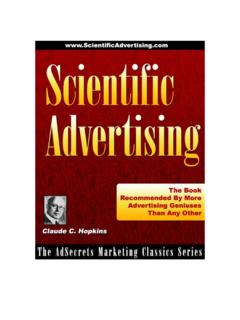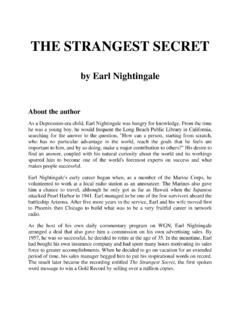Transcription of Scientific Advertising
1 Scientific Advertising By Claude C. Hopkins Published by Carl Galletti Phoenix, AZ Web Sites: This illustrated edition: Copyright 2008, 2017 by Carl Galletti How To Get the Best Use From This Book It was written many years ago and uses words which may be unfamiliar or have a slightly different meaning than commonly used today. Get over it. Otherwise, you won t be able to glean the gems it contains and that would be a waste. There is much to be gained from within its pages. After It Is The Book Recommended by More Advertising Geniuses Than Any Other Marketing Genius, Jay Abraham, once told me he had read this book more than 60 times and felt it was the impetus to launch his career as one of the most sought after and respected marketers, commanding $2, per hour for his phone and in-person consultations (later raised to $3,000 and then $5,000 and more), up to $25,000 for his training seminars and $50-$100,000 to write an ad for clients (plus a percent of the profits).
2 Jay first introduced Scientific Advertising to me through his Your Marketing Genius At Work 12-issue newsletter that sold for $ in 1986. He reprinted the ENTIRE book in his third issue. David Ogilvy wrote an introduction to the 1960 edition of Scientific Advertising , published by Crown Publishing, New York. In part, he said: Nobody, at any level, should be allowed to have anything to do with Advertising until he has read this book seven times. It changed the course of my life. He went on to say, Claude Hopkins wrote it in 1923. Rosser Reeves, bless him, gave it to me in 1938. Since then, I have given 379 copies to clients and colleagues. Every time I see a bad advertisement, I say to myself, The man who wrote this copy has never read Claude Hopkins.
3 If you read this book of his, you will never write another bad advertisement and never approve one either. Don t be put off by Hopkins staccato, graceless style. He thought that illustrations were a waste of space. Perhaps they were less important fifty years ago, when magazines and newspapers were thinner, and competition for the reader s attention less severe. But forty-two years after Hopkins wrote this book, almost everybody would agree with the following conclusions: Almost any question can be answered, cheaply, quickly and finally, by a test campaign. And that s the way to answer them not by arguments around a table. The only purpose of Advertising is to make sales.
4 It is profitable or unprofitable according to its actual sales. Ad-writers abandon their parts. They forget they are salesmen and try to be performers. Instead of sales, they seek applause. Don t try to be amusing. Money spending is a serious matter. Whenever possible we introduce a personality into our ads. By making a man famous we make his product famous. It is not uncommon for a change in headlines to multiply returns from five to ten times over. Some say, Be very brief. People will read but little. Would you say that to a salesman? Brief ads are never keyed. Every traced ad tells a complete story. The more you tell the more you sell. We try to give each advertiser a becoming style.
5 He is given an individuality best suited to the people he addresses. To create the right individuality is a supreme accomplishment. Never weary of that part. Platitudes and generalities roll off the human understanding like water from a duck. Actual figures are not generally discounted. Specific facts, when stated, have their full weight and effect. Ogilvy went on to say, In 1908, when Hopkins was forty-one, he was hired by Albert Lasker to write copy for Lord & Thomas. Lasker paid him $185,000 a year equivalent to $639,000 in today s money. [Ed: $4,634, in 2017 dollars Source: The Bureau of Labor Statistics annual Consumer Price Index]. From his typewriter came campaigns which made a long list of products famous and profitable.
6 They include Pepsodent and Palmolive. He was more than a copywriter in today s narrow sense of the word. He was a total Advertising man. He invented ways to force distribution for new products. He invented test marketing. He invented sampling. He invented copy research. He invented brand images. He invented pre-empting the truth. And he wrote copy which sold merchandise. He used to say, No argument in the world can ever compare with one dramatic demonstration. Which makes me think that he would have been as successful in television today as he was in print fifty years ago. [Ed: ..and on the Internet today] In later life, Hopkins came to resent the fact that he had made so many of his clients richer than himself.
7 In Ogilvy on Advertising , Ogilvy called Hopkins: the father of modern Advertising . In The Mirror Makers: A History of American Advertising and Its Creators, author Stephen Fox said of Hopkins: On a list of the great copywriters of all time, most students of Advertising history would rank Hopkins first. Chapter 1 How Advertising Laws Are Established The time has come when Advertising has in some hands reached the status of a science. It is based on fixed principles and is reasonably exact. The causes and effects have been analyzed until they are well understood. The correct method of procedure have been proved and established. We know what is most effective, and we act on basic law.
8 Advertising , once a gamble, has thus become, under able direction, one of the safest business ventures. Certainly no other enterprise with comparable possibilities need involve so little risk. Therefore, this book deals, not with theories and opinions, but with well-proved principles and facts. It is written as a text book for students and a safe guide for advertisers. Every statement has been weighed. The book is confined to establish fundamentals. If we enter any realms of uncertainty we shall carefully denote them. The present status of Advertising is due to many reasons. Much national Advertising has long been handled by large organizations known as Advertising agencies. Some of these agencies, in their hundreds of campaigns, have tested and compared the thousands of plans and ideas.
9 The results have been watched and recorded, so no lessons have been lost. Such agencies employ a high grade of talent. None but able and experienced men can meet the requirements in national Advertising . Working in co-operation, learning from each other and from each new undertaking, some of these men develop into masters. Individuals may come and go, but they leave their records and ideas behind them. These become a part of the organization's equipment, and a guide to all who follow. Thus, in the course of decades, such agencies become storehouses of Advertising experiences, proved principles, and methods. The larger agencies also come into intimate contact with experts in every department of business.
10 Their clients are usually dominating concerns. So they see the results of countless methods and polices. They become a clearing house for every thing pertaining to merchandising. Nearly every selling question which arises in business is accurately answered by many experiences. Under these conditions, where they long exist, Advertising and merchandising become exact sciences. Every course is charted. The compass of accurate knowledge directs the shortest, safest, cheapest course to any destination. We learn the principles and prove them by repeated tests. This is done through keyed Advertising , by traced returns, largely by the use of coupons. We compare one way with many others, backward and forward, and record the results.


